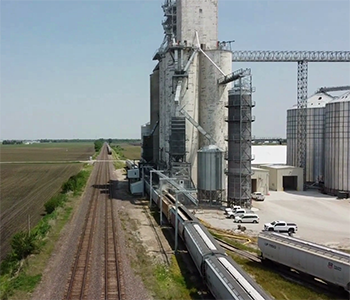The Power of Being Dynamic
Jul 11, 2023

Zack Gardner
Grain Marketing & Origination Specialist
THE PAST MONTH has been all about the weather. We could argue that if we were to have a dry spell at any point in the crop year, this would be the time to have it. On the other hand, the dryness we’ve been experiencing is making everyone nervous, including the Funds traders. Every analyst and broker out there is talking about the weather. So instead of being the millionth person talking about the same forecast that may or may not be accurate, let’s take a different approach. Like Boyd’s article, let’s talk about where your grain has gone this year!
It’s been a unique year. Corn had a significant drought out in the Beef Belt (Nebraska down through the Texas panhandle), which had a very strong demand pull for most of the year. For soybeans, there was a huge fear in the export market with how dry South America was, so there was a huge pull for exportable soybeans prior to Brazil’s large February harvest. How did that impact the flow of bushels here in Central Iowa? (Note: The below data measures only elevator bushels, not direct-ship bushels to end users.)
Truck vs. Rail: 55 percent of the bushels in the elevators have been shipped via truck, and 45 percent have been shipped via rail.
Crush, Feed or Export: For corn, 70 percent has been crushed for ethanol and 30 percent has been used for feed. For soybeans, 51 percent has been crushed and 49 percent has been exported.
Corn Trains: Probably the most interesting of the statistics this year is where all the loaded trains have gone. Key has loaded approximately 11 million bushels of corn between our Newton and Nevada facilities. Here’s a breakdown of the various states we’ve sent corn to:
Grain Marketing & Origination Specialist
THE PAST MONTH has been all about the weather. We could argue that if we were to have a dry spell at any point in the crop year, this would be the time to have it. On the other hand, the dryness we’ve been experiencing is making everyone nervous, including the Funds traders. Every analyst and broker out there is talking about the weather. So instead of being the millionth person talking about the same forecast that may or may not be accurate, let’s take a different approach. Like Boyd’s article, let’s talk about where your grain has gone this year!
It’s been a unique year. Corn had a significant drought out in the Beef Belt (Nebraska down through the Texas panhandle), which had a very strong demand pull for most of the year. For soybeans, there was a huge fear in the export market with how dry South America was, so there was a huge pull for exportable soybeans prior to Brazil’s large February harvest. How did that impact the flow of bushels here in Central Iowa? (Note: The below data measures only elevator bushels, not direct-ship bushels to end users.)
Truck vs. Rail: 55 percent of the bushels in the elevators have been shipped via truck, and 45 percent have been shipped via rail.
Crush, Feed or Export: For corn, 70 percent has been crushed for ethanol and 30 percent has been used for feed. For soybeans, 51 percent has been crushed and 49 percent has been exported.
Corn Trains: Probably the most interesting of the statistics this year is where all the loaded trains have gone. Key has loaded approximately 11 million bushels of corn between our Newton and Nevada facilities. Here’s a breakdown of the various states we’ve sent corn to:
- Iowa – 3,525,471 bushels (32.8 percent)
- Arizona – 2,616,663 bushels (24.4 percent)
- California – 2,596,277 bushels (24.2 percent)
- Idaho – 548,321 bushels (5.1 percent)
- Nevada – 455,000 bushels (4.2 percent)
- Kansas – 435,827 bushels (4.1 percent)
- Utah – 289,678 bushels (2.7 percent)
- Texas – 210,373 bushels (2.0 percent)
- Oregon – 55,887 bushels (0.5 percent)
- Iowa – 2,076,402 bushels (42.5 percent)
- Mexico – 1,628,596 bushels (33.3 percent)
- Texas – 775,221 bushels (15.9 percent)
- Washington – 409,774 bushels (8.4 percent)